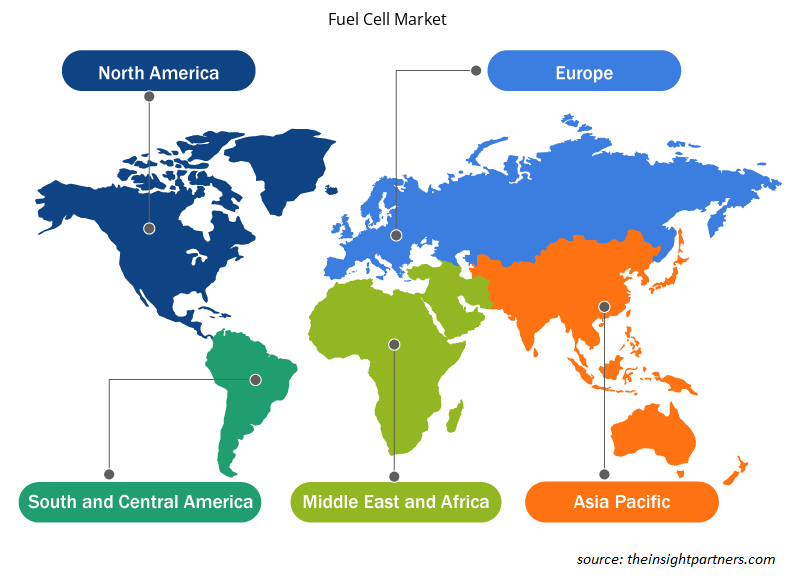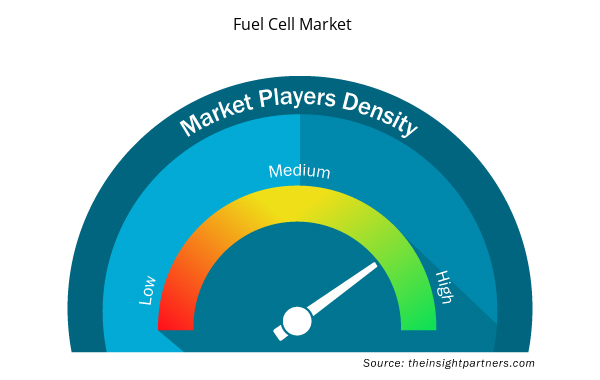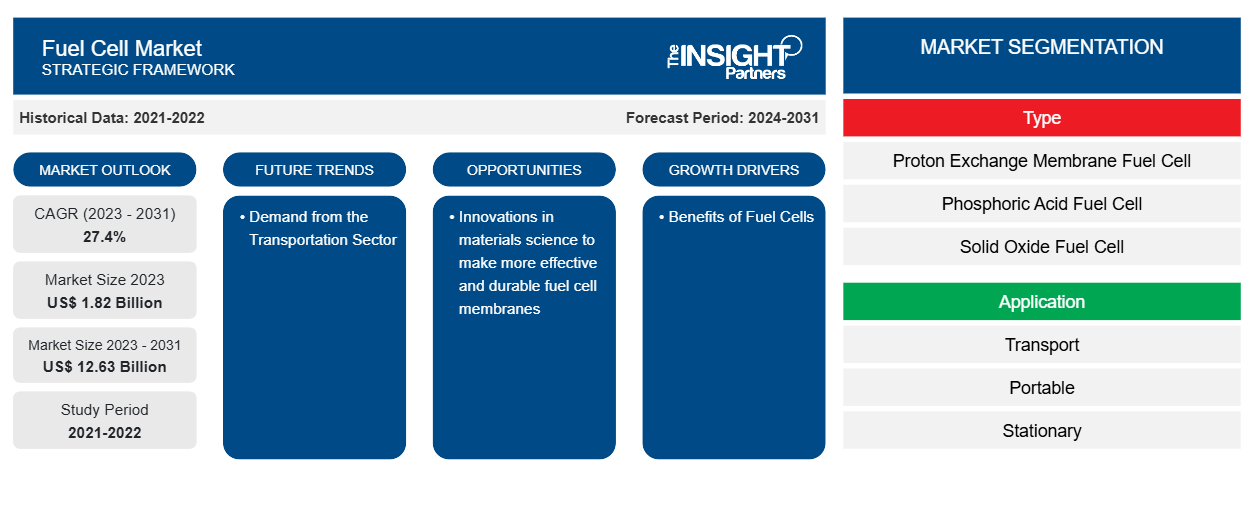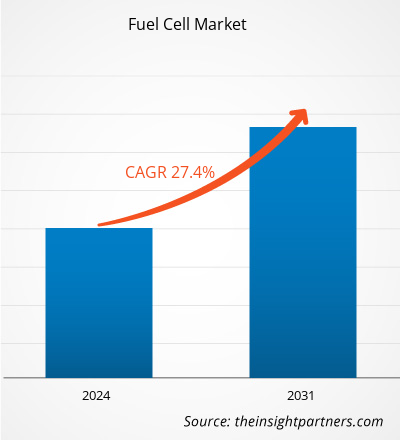Der Brennstoffzellenmarkt soll von 1,82 Milliarden US-Dollar im Jahr 2023 auf 12,63 Milliarden US-Dollar im Jahr 2031 anwachsen. Der Markt soll zwischen 2023 und 2031 eine durchschnittliche jährliche Wachstumsrate (CAGR) von 27,4 % verzeichnen. Die Vorteile von Brennstoffzellen gegenüber herkömmlichen Verbrennungstechnologien und die wachsende Nachfrage nach unkonventionellen Energiequellen dürften weiterhin der Schlüssel zu den Brennstoffzellenmarkttrends sein.
Brennstoffzellen-Marktanalyse
Die wachsende Verbrauchernachfrage nach nicht-konventionellen Energiequellen ist einer der Haupttreiber. Die Verringerung der Umweltbelastung dürfte die Nachfrage nach Brennstoffzellentechnologien ankurbeln. Es wird erwartet, dass Regierungen überall diese Fortschritte mit Unterstützung in verschiedenen Formen ergänzen werden, beispielsweise durch die Finanzierung von Forschungs- und Entwicklungsinitiativen und entsprechenden Finanzierungsprogrammen. Darüber hinaus stützen die staatlichen Initiativen und Investitionen zur Förderung des Marktes für Elektrofahrzeuge das Marktwachstum weiter.
Marktübersicht für Brennstoffzellen
Eine Brennstoffzelle erzeugt Strom effektiv und sauber, indem sie die chemische Energie von Wasserstoff oder anderen Brennstoffen nutzt. Die einzigen Nebenprodukte, wenn Wasserstoff der Brennstoff ist, sind Wärme, Wasser und Strom. Die Bandbreite der möglichen Einsatzmöglichkeiten von Brennstoffzellen macht sie einzigartig; sie können Systeme von der Größe eines Kraftwerks bis hin zur Größe eines Laptops mit Strom versorgen und dabei eine Vielzahl von Brennstoffen und Ausgangsstoffen verwenden.
Passen Sie diesen Bericht Ihren Anforderungen an
Sie erhalten kostenlos individuelle Anpassungen an jedem Bericht, einschließlich Teilen dieses Berichts oder einer Analyse auf Länderebene, eines Excel-Datenpakets sowie tolle Angebote und Rabatte für Start-ups und Universitäten.
- Holen Sie sich die wichtigsten Markttrends aus diesem Bericht.Dieses KOSTENLOSE Beispiel umfasst eine Datenanalyse von Markttrends bis hin zu Schätzungen und Prognosen.
Treiber und Chancen auf dem Brennstoffzellenmarkt
Vorteile von Brennstoffzellen begünstigen den Markt
Brennstoffzellen können für eine Vielzahl von Anwendungen eingesetzt werden, darunter Transport, Industrie-/Gewerbe-/Wohngebäude und die langfristige Energiespeicherung im Netz in reversiblen Systemen. Brennstoffzellen haben gegenüber herkömmlichen verbrennungsbasierten Technologien zahlreiche Vorteile. Darüber hinaus werden sie in verschiedenen Kraftwerken und Fahrzeugen eingesetzt. Sie können mit einem höheren Wirkungsgrad als Verbrennungsmotoren arbeiten und die chemische Energie im Kraftstoff mit einem Wirkungsgrad von über 60 % direkt in elektrische Energie umwandeln. Im Vergleich zu Verbrennungsmotoren stoßen Brennstoffzellen weniger oder keine Emissionen aus. Wasserstoff-Brennstoffzellen stoßen nur Wasser aus und lösen kritische Klimaprobleme ohne Kohlendioxidemissionen. Außerdem entstehen am Einsatzort keine Luftschadstoffe, die Smog oder Gesundheitsprobleme verursachen. Brennstoffzellen sind im Betrieb geräuscharm, da sie nur wenige bewegliche Teile haben.
Nachfrage aus dem Transportsektor
Der Brennstoffzellenmarkt ist eine Branche, die schnell wächst und viele verschiedene Geschäftsmöglichkeiten bietet. Die Technologie entwickelt sich ständig weiter und neue Designs und Materialien führen zu höherer Leistung und Effizienz. Dadurch werden Brennstoffzellen für eine größere Vielfalt an Anwendungen attraktiver. Der Brennstoffzellenmarkt ist einer der größten im Transportsektor. Im Vergleich zu batteriebetriebenen Elektrofahrzeugen (BEVs) haben Brennstoffzellen- Elektrofahrzeuge (FCEVs) eine Reihe von Vorteilen, darunter eine größere Reichweite und schnellere Tankzeiten. Es wird erwartet, dass Brennstoffzellenfahrzeuge einen schnell wachsenden Marktanteil verzeichnen werden, da die Kosten für FCEVs sinken und die Wasserstoffinfrastruktur ausgebaut wird. Verschiedene Initiativen der Regierung zur Stärkung des Marktes für Elektrofahrzeuge in den kommenden Jahren können eine enorme Chance für das Wachstum des Brennstoffzellenmarktes schaffen.
Segmentierungsanalyse des Brennstoffzellenmarktberichts
Wichtige Segmente, die zur Ableitung der Brennstoffzellenmarktanalyse beigetragen haben, sind Typ, Anwendung und Endbenutzer.
- Basierend auf dem Typ ist der Markt in Protonenaustauschmembran-Brennstoffzellen (PEMFC), Phosphorsäure-Brennstoffzellen (PAFC), Festoxid-Brennstoffzellen (SOFC) und andere unterteilt. Das Segment der Protonenaustauschmembran-Brennstoffzellen (PEMFC) hatte im Jahr 2023 einen größeren Marktanteil.
- Nach Anwendung ist der Markt in Transport, tragbar und stationär segmentiert. Das stationäre Segment hatte im Jahr 2023 einen größeren Marktanteil.
- Nach Endverbraucher ist der Markt in Brennstoffzellenfahrzeuge, Versorgungsunternehmen, Verteidigung und andere segmentiert. Das Versorgungssegment hielt im Jahr 2023 einen größeren Marktanteil.
Brennstoffzellen-Marktanteilsanalyse nach geografischer Lage
Der geografische Umfang des Brennstoffzellenmarktberichts ist hauptsächlich in fünf Regionen unterteilt: Nordamerika, Asien-Pazifik, Europa, Naher Osten und Afrika sowie Südamerika/Süd- und Mittelamerika.
In Bezug auf den Umsatz hatte der asiatisch-pazifische Raum im Jahr 2023 den größten Marktanteil auf dem Brennstoffzellenmarkt. Autohersteller wie Yamaha, Toyota und andere unternehmen Schritte, um Brennstoffzellentechnologien zu fördern, was zum Wachstum des Brennstoffzellenmarktes im asiatisch-pazifischen Raum führt. Im Einklang mit seiner Mission „Glück für alle schaffen“, die zum Aufbau einer „zukunftssicheren“, nachhaltigen Gesellschaft im Einklang mit der Natur beitragen soll, hat Toyota beispielsweise im Januar 2023 grüne und saubere Technologien entwickelt, die die Nachhaltigkeit in allen Regionen fördern. Als Pionier bei elektrifizierten und anderen umweltfreundlichen Fahrzeugtechnologien ist das Unternehmen bestrebt, eine Reihe von elektrifizierten und mit alternativen Kraftstoffen betriebenen Fahrzeugen anzubieten, um die CO2-Emissionen zu minimieren, indem es die Energieerzeugung, die Infrastrukturbereitschaft und die Verbraucherakzeptanz jedes Landes/jeder Region berücksichtigt. Darüber hinaus hat sich Toyota weltweit zur CO2-Neutralität bis 2050 verpflichtet und strebt an, bis 2035 in den Fertigungsbetrieben eine Netto-CO2-Neutralität zu erreichen.
Regionale Einblicke in den Brennstoffzellenmarkt
Die regionalen Trends und Faktoren, die den Brennstoffzellenmarkt im Prognosezeitraum beeinflussen, wurden von den Analysten von Insight Partners ausführlich erläutert. In diesem Abschnitt werden auch die Brennstoffzellenmarktsegmente und die Geografie in Nordamerika, Europa, im asiatisch-pazifischen Raum, im Nahen Osten und Afrika sowie in Süd- und Mittelamerika erörtert.

- Erhalten Sie regionale Daten zum Brennstoffzellenmarkt
Umfang des Brennstoffzellenmarktberichts
| Berichtsattribut | Details |
|---|---|
| Marktgröße im Jahr 2023 | 1,82 Milliarden US-Dollar |
| Marktgröße bis 2031 | 12,63 Milliarden US-Dollar |
| Globale CAGR (2023 - 2031) | 27,4 % |
| Historische Daten | 2021-2022 |
| Prognosezeitraum | 2024–2031 |
| Abgedeckte Segmente | Nach Typ
|
| Abgedeckte Regionen und Länder | Nordamerika
|
| Marktführer und wichtige Unternehmensprofile |
|
Dichte der Akteure auf dem Brennstoffzellenmarkt: Die Auswirkungen auf die Geschäftsdynamik verstehen
Der Brennstoffzellenmarkt wächst rasant, angetrieben durch die steigende Endverbrauchernachfrage aufgrund von Faktoren wie sich entwickelnden Verbraucherpräferenzen, technologischen Fortschritten und einem größeren Bewusstsein für die Vorteile des Produkts. Mit steigender Nachfrage erweitern Unternehmen ihr Angebot, entwickeln Innovationen, um die Bedürfnisse der Verbraucher zu erfüllen, und nutzen neue Trends, was das Marktwachstum weiter ankurbelt.
Die Marktteilnehmerdichte bezieht sich auf die Verteilung der Firmen oder Unternehmen, die in einem bestimmten Markt oder einer bestimmten Branche tätig sind. Sie gibt an, wie viele Wettbewerber (Marktteilnehmer) in einem bestimmten Marktraum im Verhältnis zu seiner Größe oder seinem gesamten Marktwert präsent sind.
Die wichtigsten auf dem Brennstoffzellenmarkt tätigen Unternehmen sind:
- Cummins Inc.
- FuelCeIl Energy, Inc.
- Plug Power Inc.
- Bloom Energie
- Ballard-Energiesysteme
- SFC Energy AG
Haftungsausschluss : Die oben aufgeführten Unternehmen sind nicht in einer bestimmten Reihenfolge aufgeführt.

- Überblick über die wichtigsten Akteure auf dem Brennstoffzellenmarkt
Neuigkeiten und aktuelle Entwicklungen zum Brennstoffzellenmarkt
Der Brennstoffzellenmarkt wird durch die Erhebung qualitativer und quantitativer Daten nach Primär- und Sekundärforschung bewertet, die wichtige Unternehmensveröffentlichungen, Verbandsdaten und Datenbanken umfasst. Im Folgenden finden Sie eine Liste der Entwicklungen auf dem Markt:
- Im September 2023 hat Indiens Unionsminister für Erdöl und Erdgas sowie Wohnungsbau und Stadtentwicklung in einem bedeutenden Schritt in Richtung grüne Mobilität den ersten grünen Wasserstoff-Brennstoffzellenbus auf dem Kartavya Path in Delhi losgeschickt. (Quelle: Ministerium für Erdöl und Erdgas, Pressemitteilung, 2023)
- Im März 2024 stellte Hyzon (NASDAQ: HYZN), ein in den USA ansässiger führender Entwickler von Wasserstoff-Brennstoffzellentechnologie und globaler Anbieter von emissionsfreien schweren Brennstoffzellen-Elektrofahrzeugen (FCEVs), sein Single-Stack-200-kW-Brennstoffzellensystem und seinen Antriebsstrang in einem Fahrzeug vor. Dies geschah bei einer Zeremonie, an der Regierungsvertreter, Betreiber schwerer Flotten sowie Mitarbeiter und Führungskräfte des Unternehmens teilnahmen. (Quelle: PR Newswire, Pressemitteilung, 2024)
- Im Januar 2024 testete die ISRO erfolgreich ein 100-W-Stromversorgungssystem (FCPS) auf Basis einer Polymerelektrolytmembran-Brennstoffzelle der Klasse 3 auf ihrer Orbitalplattform POEM3, die am 1. Januar 2024 an Bord von PSLV-C58 gestartet wurde. Ziel des Experiments war es, den Betrieb von Polymerelektrolytmembran-Brennstoffzellen im Weltraum zu bewerten und Daten zu sammeln, um die Entwicklung von Systemen für zukünftige Missionen zu erleichtern. Während des Kurzzeittests an Bord von POEM wurden 180 W Leistung aus Wasserstoff- und Sauerstoffgasen erzeugt, die an Bord in Hochdruckbehältern gespeichert waren. Es lieferte eine Fülle von Daten zur Leistung verschiedener statischer und dynamischer Systeme, die Teil des Stromsystems waren, und zur physikalischen Wirkung. (Quelle: ISRO, Pressemitteilung, 2024)
Marktbericht zum Brennstoffzellenmarkt: Umfang und Ergebnisse
Der Bericht „Marktgröße und Prognose für Brennstoffzellen (2021–2031)“ bietet eine detaillierte Analyse des Marktes, die die folgenden Bereiche abdeckt:
- Marktgröße und Prognose auf globaler, regionaler und Länderebene für alle wichtigen Marktsegmente, die im Rahmen des Projekts abgedeckt sind
- Marktdynamik wie Treiber, Beschränkungen und wichtige Chancen
- Wichtige Zukunftstrends
- Detaillierte PEST/Porters Five Forces- und SWOT-Analyse
- Globale und regionale Marktanalyse mit wichtigen Markttrends, wichtigen Akteuren, Vorschriften und aktuellen Marktentwicklungen
- Branchenlandschaft und Wettbewerbsanalyse, einschließlich Marktkonzentration, Heatmap-Analyse, prominenten Akteuren und aktuellen Entwicklungen
- Detaillierte Firmenprofile
- Historische Analyse (2 Jahre), Basisjahr, Prognose (7 Jahre) mit CAGR
- PEST- und SWOT-Analyse
- Marktgröße Wert/Volumen – Global, Regional, Land
- Branche und Wettbewerbsumfeld
- Excel-Datensatz



Report Coverage
Revenue forecast, Company Analysis, Industry landscape, Growth factors, and Trends

Segment Covered
This text is related
to segments covered.

Regional Scope
North America, Europe, Asia Pacific, Middle East & Africa, South & Central America

Country Scope
This text is related
to country scope.
Häufig gestellte Fragen
The global fuel cell market was estimated to be US$ 1.82 billion in 2023 and is expected to grow at a CAGR of 27.4% during the forecast period 2023 - 2031.
The benefits of fuel cells over traditional combustion-based technologies and the growing demand for unconventional energy sources are the major factors that propel the global fuel cell market.
Innovations in materials science to make more effective and durable fuel cell membranes are anticipated to play a significant role in the global fuel cell market in the coming years.
The key players holding majority shares in the global fuel cell market are Cummins Inc.; FuelCeIl Energy, Inc.; Ballard Power Systems; SFC Energy AG; and Intelligent Energy Limited.
The global fuel cell market is expected to reach US$ 12.63 billion by 2031.
The incremental growth expected to be recorded for the global fuel cell market during the forecast period is US$ 10.81 billion.
Trends and growth analysis reports related to Energy and Power : READ MORE..
The Insight Partners performs research in 4 major stages: Data Collection & Secondary Research, Primary Research, Data Analysis and Data Triangulation & Final Review.
- Data Collection and Secondary Research:
As a market research and consulting firm operating from a decade, we have published and advised several client across the globe. First step for any study will start with an assessment of currently available data and insights from existing reports. Further, historical and current market information is collected from Investor Presentations, Annual Reports, SEC Filings, etc., and other information related to company’s performance and market positioning are gathered from Paid Databases (Factiva, Hoovers, and Reuters) and various other publications available in public domain.
Several associations trade associates, technical forums, institutes, societies and organization are accessed to gain technical as well as market related insights through their publications such as research papers, blogs and press releases related to the studies are referred to get cues about the market. Further, white papers, journals, magazines, and other news articles published in last 3 years are scrutinized and analyzed to understand the current market trends.
- Primary Research:
The primarily interview analysis comprise of data obtained from industry participants interview and answers to survey questions gathered by in-house primary team.
For primary research, interviews are conducted with industry experts/CEOs/Marketing Managers/VPs/Subject Matter Experts from both demand and supply side to get a 360-degree view of the market. The primary team conducts several interviews based on the complexity of the markets to understand the various market trends and dynamics which makes research more credible and precise.
A typical research interview fulfils the following functions:
- Provides first-hand information on the market size, market trends, growth trends, competitive landscape, and outlook
- Validates and strengthens in-house secondary research findings
- Develops the analysis team’s expertise and market understanding
Primary research involves email interactions and telephone interviews for each market, category, segment, and sub-segment across geographies. The participants who typically take part in such a process include, but are not limited to:
- Industry participants: VPs, business development managers, market intelligence managers and national sales managers
- Outside experts: Valuation experts, research analysts and key opinion leaders specializing in the electronics and semiconductor industry.
Below is the breakup of our primary respondents by company, designation, and region:

Once we receive the confirmation from primary research sources or primary respondents, we finalize the base year market estimation and forecast the data as per the macroeconomic and microeconomic factors assessed during data collection.
- Data Analysis:
Once data is validated through both secondary as well as primary respondents, we finalize the market estimations by hypothesis formulation and factor analysis at regional and country level.
- Macro-Economic Factor Analysis:
We analyse macroeconomic indicators such the gross domestic product (GDP), increase in the demand for goods and services across industries, technological advancement, regional economic growth, governmental policies, the influence of COVID-19, PEST analysis, and other aspects. This analysis aids in setting benchmarks for various nations/regions and approximating market splits. Additionally, the general trend of the aforementioned components aid in determining the market's development possibilities.
- Country Level Data:
Various factors that are especially aligned to the country are taken into account to determine the market size for a certain area and country, including the presence of vendors, such as headquarters and offices, the country's GDP, demand patterns, and industry growth. To comprehend the market dynamics for the nation, a number of growth variables, inhibitors, application areas, and current market trends are researched. The aforementioned elements aid in determining the country's overall market's growth potential.
- Company Profile:
The “Table of Contents” is formulated by listing and analyzing more than 25 - 30 companies operating in the market ecosystem across geographies. However, we profile only 10 companies as a standard practice in our syndicate reports. These 10 companies comprise leading, emerging, and regional players. Nonetheless, our analysis is not restricted to the 10 listed companies, we also analyze other companies present in the market to develop a holistic view and understand the prevailing trends. The “Company Profiles” section in the report covers key facts, business description, products & services, financial information, SWOT analysis, and key developments. The financial information presented is extracted from the annual reports and official documents of the publicly listed companies. Upon collecting the information for the sections of respective companies, we verify them via various primary sources and then compile the data in respective company profiles. The company level information helps us in deriving the base number as well as in forecasting the market size.
- Developing Base Number:
Aggregation of sales statistics (2020-2022) and macro-economic factor, and other secondary and primary research insights are utilized to arrive at base number and related market shares for 2022. The data gaps are identified in this step and relevant market data is analyzed, collected from paid primary interviews or databases. On finalizing the base year market size, forecasts are developed on the basis of macro-economic, industry and market growth factors and company level analysis.
- Data Triangulation and Final Review:
The market findings and base year market size calculations are validated from supply as well as demand side. Demand side validations are based on macro-economic factor analysis and benchmarks for respective regions and countries. In case of supply side validations, revenues of major companies are estimated (in case not available) based on industry benchmark, approximate number of employees, product portfolio, and primary interviews revenues are gathered. Further revenue from target product/service segment is assessed to avoid overshooting of market statistics. In case of heavy deviations between supply and demand side values, all thes steps are repeated to achieve synchronization.
We follow an iterative model, wherein we share our research findings with Subject Matter Experts (SME’s) and Key Opinion Leaders (KOLs) until consensus view of the market is not formulated – this model negates any drastic deviation in the opinions of experts. Only validated and universally acceptable research findings are quoted in our reports.
We have important check points that we use to validate our research findings – which we call – data triangulation, where we validate the information, we generate from secondary sources with primary interviews and then we re-validate with our internal data bases and Subject matter experts. This comprehensive model enables us to deliver high quality, reliable data in shortest possible time.


 Holen Sie sich ein kostenloses Muster für diesen Bericht
Holen Sie sich ein kostenloses Muster für diesen Bericht